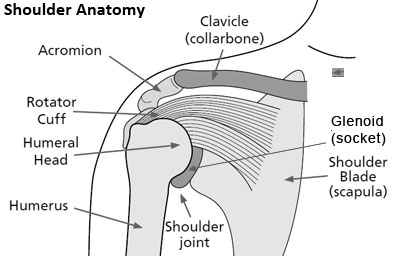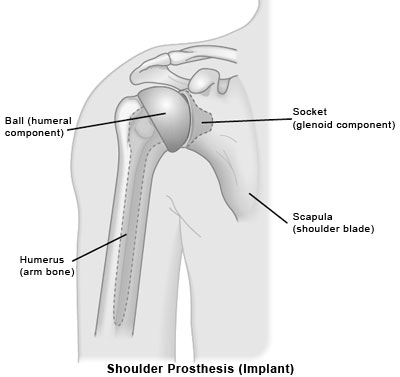


The shoulder is a ball and socket joint, made up of three bones, the humerus (upper arm bone), the scapula (shoulder blade) and the clavicle (collar bone). The ball at the top end of the humerus (humeral head) fits into the socket (glenoid) of the scapula to form the shoulder joint. The humeral head and glenoid are covered with cartilage, which allows for smooth joint motion.
The shoulder has the greatest range of motion of any joint in the body, allowing you to position your hand anywhere in space. The coordinated activity of numerous muscles working together in set patterns is required to produce this motion.
The rotator cuff is a group of muscles closely wrapped around the top of your arm bone (humerus). These muscles originate from your shoulder blade and their tendons form a cuff which covers the joint. The rotator cuff muscles are important to normal shoulder function. Together they act to stabilize and rotate the shoulder joint.
In the Arthritic shoulder the normal cartilage (smooth surface of joint) is worn away and there is bone-on-bone without the normal smooth gliding surfaces, which are able to glide on one another with little friction and wear. The joint may also become irregular from boney growth (osteophytes), which is the body's attempt to "heal" the cartilage injury.
Pain is usually due to the irregular joint surfaces rubbing on one another and from the inflammation of this wear and tear. If you can't lift your arm, perform everyday tasks or sleep at night, your doctor may recommend arthroplasty, the medical name for a shoulder replacement operation.
The surgeon removes the damaged parts of the shoulder and replaces them with artificial parts. The surgeon can replace either just the head of the humerus bone, the ball, or replace both the ball and the socket, the glenoid.
An incision is made in the front of the shoulder, and the humeral head (the ball) is removed. The new ball and stem are then inserted into the bone. If the surgeon is carrying out a total shoulder replacement, the socket side of the joint is then smoothed and the new plastic socket is attached securely in place.

If the humeral head (the ball) is severely fractured but the socket is normal, with healthy and intact cartilage, your surgeon may recommend replacing only the ball. This procedure is called hemiarthroplasty. Sometimes, surgeons make the decision between a total shoulder replacement and a hemiarthroplasty in the operating room at the time of the surgery. Studies have shown that patients with osteoarthritis get better pain relief from total shoulder replacement than from hemiarthroplasty.
Shoulder replacement materials are technologically advanced, and are identical to the materials used in knee and hip replacements. The ball and stem are made from titanium and cobalt chrome metals; the socket is made of plastic called polythene.
For a brief demo of the procedure, visit Total Shoulder Replacement